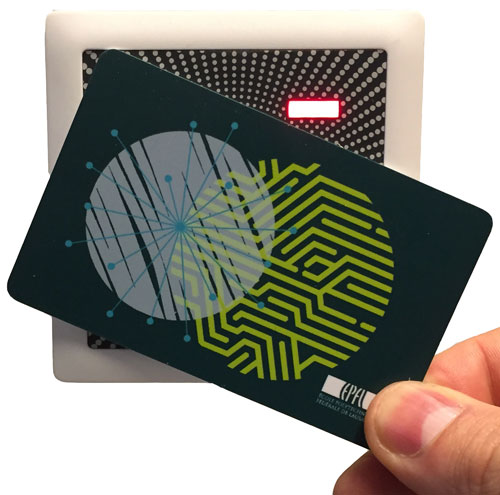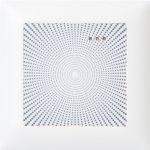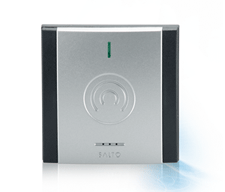This system allows us to control the access to several facilities, by restricting them to the authorized people only. The access rights to a a facility or to a faculty building are precisely defined for each user (staff, student…). The access rights are stored on a central database, and are managed by the related CAMIPRO manager, additionally to rights that are automatically granted to the user depending on his faculty.
This system is in use since 1996 on the whole EPFL site of Ecublens, and is managed by the CAE. More than 1000 doors are controlled by the CAMIPRO system, using RFID card readers (picture below).
A few doors are secured with biometric systems (fingerprint and iris), or with a numeric keyboard.

Opening your door
To open a door (and if you have the right to access the required facility), you have to pass your card over the CAMIPRO reader, as shown on the picture above. The readers read your card without any contact (in most cases, the reading distance is from 2 to 4 cm), but having metallic elements near your card or a special orientation of your card can disturb the reading, and the consequence of this is that the reading distance gets smaller.
In most cases, you don’t even have to get your CAMIPRO card our of your wallet, getting your wallet close to the reader should be enough!
There are two types of access readers on the site. Online readers are embedded in the walls and Offline readers are on the door handle.
The LED of Online reader gives an indication on the door condition :

- If it is green, the door is open (free access)
- If it is red, the access to the facility that this door closes is controled (the door is closed and you have to show your card to the reader in order for the door to open).
If the access is controled (red), you will have to pass your card over the reader :
- If the LED lights blink red, you don’t have the rights to access that facility (contact your to ask for the right).
- If the LED lights up green, you have the authorization to access the facility. The strike plate will free the door for 5 seconds.
Some access rights (typically for doors to offices, technical rooms, etc., which are equipped with an offline access control system) will require that you update your card in order to be functional.
These rights are physically stored on your card. If your card must be updated, you will receive an email informing you that you need to update your card.
To update your card, please approach your card from a Camipro hotspot and wait until the LED turns green. The card update may take up to 15 seconds.
These rights are only valid for a maximum of 3 months. Please update your card often to avoid been blocked in front of a door.
A Camipro hotspot looks like the following illustration:

Camipro hotspots
Hotspots allows you to update offline readers rights. You will find maps that show where these Camipro hotspots are located here. All CAMIPRO kiosks have an hotspot. Click on the marker to get more informations.
Principles of Access Control
The multifunction system allows :
- automatic opening and a closing of the outside of the buildings (previously manually done) at fixed times
- a permanent control of the closing of the controled doors (an alarm is sent if a controled door stays open too long)
- a management of the accesses for certain facilities for specific groups of people (for example, students of such a semester)
- to keep a trace of the opening and closing of a specific door and to consult it (only in case of a problem, and on a supervised demand of the security)
- to eliminate the problem of lost, stolen or copied keys
Kind of accesses
The are three types of access rights :
- Free access : the striker plate is free and the door is unlocked
- Controlled entry : the striker plate is activated and the door is locked. Access is restricted to those possessing access rights. You must then pass your badge near the reader in order to deactivate the striker plate and then open the door
- Exceptional : for security reasons (evacuation) or special events, the CAE can activate or deactivate a door. This happens only exceptionally.
Coque & Clock accessibility concept
The doors are controlled under the EPFL “Coque & Clock” general access concept explained below in a simple manner :
- Coque : Areas in which you must at all times present your badge to open the doors. For security reasons, these areas must permanently remain locked to unauthorized people. For instance, an example of this would be a laboratory containing hazardous materials.
- Clock : Areas that have free access during opening hours and in which you need access rights outside of these times.